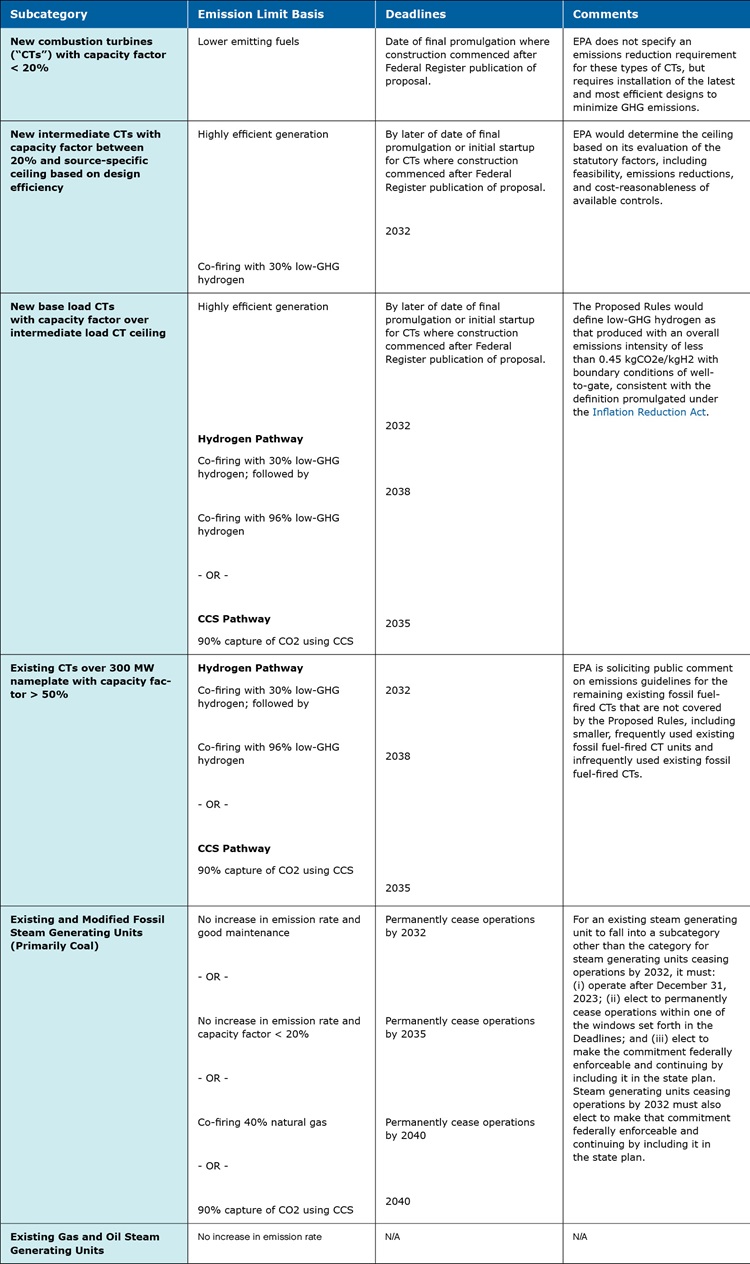
The Agency Strikes Back: EPA Proposes New Emissions Limits for Fossil Fuel-Fired Power Plants
In Short
The Situation: The Environmental Protection Agency ("EPA") has issued proposed rules to limit carbon dioxide ("CO2") emissions from fossil fuel-fired power plants (the "Proposed Rules").
The Result: The Proposed Rules would require nearly all existing fossil-fueled electricity generating units ("EGUs") to either implement carbon capture and storage, substantially replace fossil fuel with hydrogen from low-carbon processes, or shut down.
Looking Ahead: If finalized, the Proposed Rules are likely to face significant legal challenges on the basis that EPA does not have the authority to promulgate the Proposed Rules unless Congress provides a clear statement to delegate such authority—a principle established by the U.S. Supreme Court in West Virginia v. EPA.
On May 23, 2023, EPA published proposed emission limits and guidelines for CO2 emitted from nearly all existing fossil fuel-fired power plants in the Federal Register. Citing authority under Section 111 of the Clean Air Act (the "CAA"), the Proposed Rules adopt a "best system of emission reduction" ("BSER") that is "adequately demonstrated" for CO2 control by 2040. The BSER will force nearly all existing fossil-fueled electric generating units to choose to implement one of these options: (i) carbon capture and storage; (ii) substantially replace fossil fuel with hydrogen from low carbon processes; or (iii) shut down.
In addition to the BSER limits for existing sources, the Proposed Rule establishes similar limits for new gas-fired combustion turbines. If the proposed limits for new combustion turbines are finalized, they will be effective retroactively to any combustion turbines that commenced construction after the date that the Proposed Rules are published in the Federal Register.
The Proposed Rules include interim limits effective before 2040 that vary by the type of unit (new or existing, combustion turbine or utility boiler, coal-fired or natural gas-fired), how frequently it operates (base load, intermediate load, or low load (peaking)) and its operating horizon (i.e., planned operation after certain future dates). If finalized, the Proposed Rules would require states to submit plans to comply with the new GHG-emissions limitations to EPA within 24 months of the effective date of the emissions guidelines. EPA would generally require more CO2 emissions control at fossil fuel-fired power plants that operate more frequently and for more years, and would phase in increasingly stringent CO2 requirements over time based on technologies such as carbon capture and sequestration/storage ("CCS"), low-greenhouse gas ("GHG") hydrogen co-firing, and natural gas co-firing.
New and Existing Natural Gas-Fired Combustion Turbines
Under the Proposed Rules, emissions limits for natural gas-fired combustion turbines would be based on CCS and/or the use of low-GHG hydrogen, and would vary based on whether the units are new or existing and whether they are used for baseload or intermediate load generation. As set forth in the table below, the Proposed Rules would create three subcategories for new and reconstructed fossil fuel-fired combustion turbines, each subject to a different BSER and standard of performance, based on the function of the turbine: (i) a low load ("peaking units") subcategory that consists of combustion turbines with a capacity factor of less than 20%; (ii) an intermediate load subcategory for combustion turbines with a capacity factor ranging between 20% and a source-specific ceiling; and (iii) a base load subcategory for combustion turbines that operate above the ceiling threshold for intermediate load turbines.
In respect of existing combustion turbines, EPA has proposed a BSER only for frequently operated turbines that are larger than 300 MW with a capacity factor of greater than 50%. EPA provides that the states may take into account the remaining useful life and other factors when applying standards of performance to individual existing sources.
Existing Coal-Fired EGUs
EPA is proposing to repeal and replace the existing Affordable Clean Energy Rule (the "ACE Rule") emission guidelines due, in part, to the supposedly decreased costs of CCS and natural gas co-firing. As a result, EPA considered CCS and natural gas co-firing as candidates for BSER for existing coal-fired steam EGUs. For EGUs that plan to operate in the long-term, the Proposed Rule concludes that the BSER is CCS with 90% capture of CO2. For EGUs that commit to ceasing operations prior to 2040, the applicable BSER would depend on the date by which the EGU will cease operations. EPA justifies this approach by noting that it recognized that CCS will be most cost-effective for existing steam EGUs that are in a position to recover the capital costs associated with CCS over a sufficiently long period of time. The subcategories and emissions limitations for steam EGUs are identified in the table below.

Regulatory Impact Analysis
In accordance with Executive Orders 12866 and 13563 and applicable guidelines, EPA published a regulatory impact analysis ("RIA") to analyze the benefits and costs associated with the projected emissions reductions under the Proposed Rules. EPA asserts that in 2020, 25% of the United States' total GHG emissions were attributable to fossil fuel-fired EGUs and posits that the Proposed Rules are necessary to correct the negative externality of atmospheric pollution caused by electricity producers.
EPA explains that if these fossil fuel-fired electricity producers pollute the atmosphere when generating power, the social costs will not be borne exclusively by the polluting firm, but rather by society as a whole. EPA notes the equilibrium market price of electricity may fail to incorporate the full opportunity cost to society of these products, and consequently, producers may not internalize the social cost of emissions, and social costs will be higher as a result absent a regulation on emissions. The Proposed Rules would work toward addressing this supposed market failure by causing affected producers to more fully internalize the negative externality associated with GHG emissions from electricity generation by new and existing fossil fuel-fired stationary combustion turbine EGUs and existing fossil fuel-fired steam generating EGUs.
Further, EPA justifies the proposed repeal of the ACE Rule on the basis that the heat rate improvements at coal-fired EGUs were expected to provide negligible CO2 reductions and, accordingly, that such measures are not the appropriate BSER for existing coal-fired EGUs. EPA projected in the RIA for the ACE Rule published in June 2019 a reduction of approximately 11 million short tons of CO2 emissions, whereas EPA now projects that the Proposed Rules will result in a reduction of 89 million metric tons of CO2 emissions.
EPA has previously concluded that GHG emissions endanger public health and welfare. 74 FR 66496 (December 15, 2009). Under Section 111 of the CAA, EPA is required to promulgate a list of categories of stationary sources that cause, or contribute significantly to, "air pollution which may reasonably be anticipated to endanger public health or welfare." 42 U.S.C. § 7411(b)(1). Though EPA points to public health and welfare as its primary justification, the RIA explores "broad [industry] trends away from coal-fired generation and toward lower-emitting generation" in its analysis, noting "substantial structural changes in both the mix of generating capacity and in the share of electricity generation supplied by different types of generation" over the last decade. EPA also acknowledges a range of studies that it believes confirm market trends of declining costs for renewable energy generation due to technological advances, performance improvements, and government incentives.
Return of the Major Questions Doctrine
While EPA hedges that "systems of emissions reduction like fuel switching, add-on controls, and efficiency improvements fall comfortably within the scope of prior practice as recognized by the Supreme Court," the Proposed Rules are likely to face significant legal challenges on the basis of the major questions doctrine established in West Virginia v. EPA.
In 2015, EPA issued the Clean Power Plan (the "Plan") to curb GHG emissions by forcing power plants to shift from certain energy sources, like coal, to other lower-emitting sources, like wind and solar. The Plan established a BSER that existing fossil fuel-fired power plants could not meet by installing cleaner technologies. Instead, the Plan would have required plants to reduce their production, shift their generation from coal to natural gas and renewables, or permanently close to meet the new targets. In a case argued by Jones Day, West Virginia v. EPA, 142 S. Ct. 2587 (2022), the Supreme Court reached a 6–3 decision that Congress did not grant EPA the authority to create emissions caps based on generation shifting, thereby invalidating the Plan.
The Supreme Court relied on the "major questions" doctrine to conclude that the Plan exceeded EPA's authority under the CAA. Specifically, the Supreme Court found that EPA's attempt to impose emissions caps by shifting electricity production from higher-emitting to lower-emitting products represented a "major question" of economic and political significance. Under the "major questions" doctrine, administrative agencies, such as EPA, do not have authority to make decisions on "major questions" unless Congress has provided a clear statement intended to delegate such extraordinary authority.
In light of the holding in West Virginia v. EPA, EPA has attempted to fit the Proposed Rules within the parameters imbued by the Supreme Court. Rather than regulate the entire grid as the Plan had attempted, EPA's Proposed Rules regulate individual power plants at the source. As EPA explains in the Proposed Rules, the Supreme Court has recognized, and EPA has determined, the BSER to be "measures that improve the pollution performance of individual sources, including add-on controls and clean fuels." We do not expect that EPA will have the last word on whether the Proposed Rule successfully navigates the hurdles posed by the major questions doctrine.
Public comments to the Proposed Rules are due July 24, 2023.
Three Key Takeaways
- EPA has published Proposed Rules limiting CO2 emissions from nearly all fossil fuel-fired power plants, asserting that these rules are necessary to correct the negative externality of atmospheric pollution caused by electricity producers.
- If EPA's Proposed Rules are finalized, existing and new fossil-fueled electric generating units will be required to comply with new and more stringent GHG-emission limitations by: (i) implementing carbon capture and storage; (ii) substantially replacing fossil fuel with hydrogen from low carbon processes; or (iii) shutting down.
- The Proposed Rules are likely to face significant legal challenges on the basis of the major questions doctrine established in West Virginia v. EPA.






